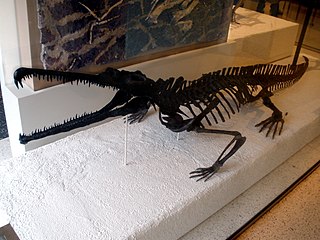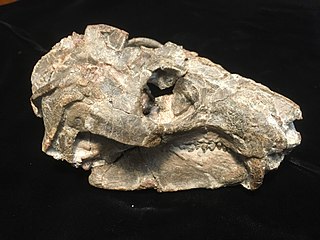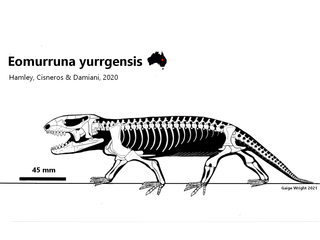
The Carnian is the lowermost stage of the Upper Triassic Series. It lasted from 237 to 227 million years ago (Ma). The Carnian is preceded by the Ladinian and is followed by the Norian. Its boundaries are not characterized by major extinctions or biotic turnovers, but a climatic event occurred during the Carnian and seems to be associated with important extinctions or biotic radiations. Another extinction occurred at the Carnian-Norian boundary, ending the Carnian age.

Adelobasileus is a genus of mammaliamorph cynodonts from the Late Triassic (Carnian), about 225 million years ago. It is known only from a partial skull recovered from the Tecovas Formation in western Texas, southern United States, referred to the species Adelobasileus cromptoni.

Blikanasaurus is a genus of sauropodomorph dinosaur from the late Triassic of South Africa. The generic name Blikanasaurus is derived from Greek, meaning "lizard from Blikana". The species name cromptoni is taken from the surname of A.W. "Fuzz" Crompton, an American paleontologist who led numerous field expeditions in Elliot Formation outcrop localities in South Africa. Blikanasaurus is only known from partial hindlimb bones that were recovered from the lower Elliot Formation (LEF) in the Eastern Cape.

Hyperodapedon is an extinct genus of rhynchosaur reptiles which lived during Late Triassic period. Like other rhynchosaurs, it was an heavily built archosauromorph, distantly related to archosaurs such as crocodilians and dinosaurs. Hyperodapedon in particular was part of the subfamily Hyperodapedontinae, a specialized rhynchosaurian subgroup with broad skulls, beaked snouts, and crushing tooth plates on the roof of the mouth.

Parasuchus is an extinct genus of basal phytosaur known from the Late Triassic of Andhra Pradesh and Madhya Pradesh, India. At its most restricted definition, Parasuchus contains a single species, Parasuchus hislopi. Parasuchus hislopi is one of several species belonging to a basal grade of phytosaurs, typified by the genus Paleorhinus. Historically, Paleorhinus has been known from better-described fossils, and many species have been lumped into that genus. Parasuchus hislopi, despite being described earlier than Paleorhinus, was considered an undiagnostic chimera until new neotype fossils were described in the late 1970s. Parasuchus hislopi and the two unambiguously valid species of Paleorhinus are all closely related; some authors have historically described them all under the species Paleorhinus, while others place the two Paleorhinus species into Parasuchus according to the principle of priority.

Rutiodon is an extinct genus of mystriosuchine phytosaurs from the Late Triassic of the eastern United States. The type species of Rutiodon, Rutiodon carolinensis, encompasses a large number of skulls and assorted postcranial fossils discovered in the Cumnock Formation of North Carolina. Fossils referable to the species are also known from Pennsylvania, New Jersey, and Virginia. Rutiodon carolinensis is the most well-described species of phytosaur in eastern North America, though its validity as a natural taxon has been questioned. Some paleontologists also recognize a larger and more robust species, Rutiodon manhattanensis, which is known from teeth and postcranial fossils from New Jersey and Pennsylvania.

Compsocerops is an extinct genus of temnospondyl amphibians recovered from the Late Triassic Upper Maleri and Tiki Formations of India, and the Santa Maria Formation of Brazil.

Clevosaurus is an extinct genus of rhynchocephalian reptile from the Late Triassic and the Early Jurassic periods. Species of Clevosaurus were widespread across Pangaea, and have been found on all continents except Australia and Antarctica. Five species of Clevosaurus have been found in ancient fissure fill deposits in south-west England and Wales, alongside other sphenodontians, early mammals and dinosaurs. In regards to its Pangaean distribution, C. hadroprodon is the oldest record of a sphenodontian from Gondwana, though its affinity to Clevosaurus has been questioned.

Ptychoceratodus is an extinct genus of lungfish living from Early Triassic to Middle Jurassic. It was established by Otto Jaekel for one species, transferred from Ceratodus genus. Type species is P. serratus from the Middle Triassic of Switzerland and Germany. Ptychoceratodus had two pairs of massive dental plates, bearing 4-6 acute ridges. Its skull roof was composed from massive, plate-like bones. In the central part of skull roof was localized an unossified fenestra. Most of the Ptychoceratodus findings are isolated dental plates, some associated with jaws. Other parts of skull or postcranial skeleton are relatively rarely found as fossils. The anatomy of skull is the best recognized in P. serratus, whereas less complete cranial material is available also for P. concinuus, P. phillipsi, and P. rectangulus. Although Ptychoceratodus is known exclusively from the Triassic and Jurassic, there were also Cretaceous specimens referred to this genus. However, they are more often regarded as representants of Metaceratodus. Ptychoceratodus is the only member of the family Ptychoceratodontidae. The first named species is P. phillipsi by Louis Agassiz in 1837 as a species of Ceratodus and later moved to Ptychoceratodus genus. Occurrences of Ptychoceratodus come mainly from Europe. However, occurrences from other continents suggest it was dispersed globally during the Triassic. After 2010, the new fossil material behind the Europe was reported from South America, India, and Greenland
The Tiki Formation is a Late Triassic geologic formation in Madhya Pradesh, northern India. Dinosaur remains are among the fossils that have been recovered from the formation, although none have yet been referred to a specific genus. Phytosaur remains attributable to the genus Volcanosuchus have also been found in the Tiki Formation.
Mitredon is an extinct genus of cynodonts which existed in the Fleming Fjord Formation of Greenland during the Rhaetian age of the Late Triassic epoch. The type and only species is Mitredon cromptoni.
Rewaconodon is an extinct genus of dromatheriid cynodonts which existed in India during the upper Triassic period. It is known from two species: R. tikiensis and R. indicus, both of which were found in the Tiki Formation. Other, undescribed species may have lived in North America.
Tikisuchus is an extinct genus of rauisuchid archosauromorph. It is known from the Late Triassic Tiki Formation in the Shahdol District of central India and was the first rauisuchid to have been found in Asia. The horizon from which remains have been found is Carnian in age. The type species is T. romeri, named in honor of American paleontologist Alfred Romer. Romer was present at the Tiki locality during the excavation of the fossil, but died before the description of the genus in 1987. Tikisuchus is known only from one specimen, called ISI R 305, which consists of the skull and some postcranial elements of a young individual.

Antarctosuchus is an extinct genus of capitosauroid temnospondyl known from the Middle Triassic upper Fremouw Formation in the Transantarctic Mountains of Antarctica. It contains a single species, Antarctosuchus polyodon.
Ruberodon is an extinct genus of traversodontid cynodonts known from the type and only species Ruberodon roychowdhurii from the Late Triassic of India. Ruberodon was named in 2015 on the basis of several isolated lower jaws found in the Tiki Formation. The lower jaw of Ruberodon has three pairs of incisors, one pair of canines, and 9 pairs of postcanine teeth. The first pair of incisors is enlarged and protrudes forward from the tip of the jaw and there is a gap called a diastema between the canines and postcanines. Phylogenetic analysis indicates that among traversodontids, R. roychowdhurii is most closely related to Exaeretodon statisticae, which is also from India.

Aleodon is an extinct genus of cynodonts that lived from the Middle to the Late Triassic. Relatively few analyses have been conducted to identify the phylogenetic placement of Aleodon, however those that have place Aleodon as a sister taxon to Chiniquodon. Two species of Aleodon are recognized: A. brachyramphus which was discovered in Tanzania, and A. cromptoni which was discovered most recently in Brazil.
Palacrodon is an extinct genus of Triassic reptile with a widespread distribution. It was initially described from teeth collected in Early Triassic deposits in South Africa, and later reported from the Early Triassic of Antarctica and the Late Triassic of Arizona. Although previously considered an early rhynchocephalian, it is currently considered to be a non-saurian neodiapsid.
Tikitherium is an extinct genus of mammaliaforms from India, known from a single upper tooth. Originally argued to be a primitive mammaliaform from the Late Triassic, a 2024 study argued that it actually represented the remains of a shrew from the Neogene. Tikitherium refers to Tiki, the village located near the Tiki Formation where the specimen was originally thought to have come from, and therium is Greek for “Beast”. The species was named copei in honor of Edward Drinker Cope for his pioneering discoveries towards understanding mammalian molars.

Eomurruna is a genus of procolophonid reptile that existed in what is now Queensland, Australia during the Early Triassic period. The genus is made up of a single species, E. yurrgensis, originally uncovered within the Arcadia Formation in 1985. Since then over 40 specimens have been referred to the genus, making Eomurruna one of the most complete organisms so far found from the Mesozoic of Australia.
Inditherium is an extinct genus of dromatheriid cynodonts that lived in what is now India during the Late Triassic. Its type and only species is Inditherium floris, which is known from three postcanine teeth discovered at the Tiki Formation of Madhya Pradesh.

















